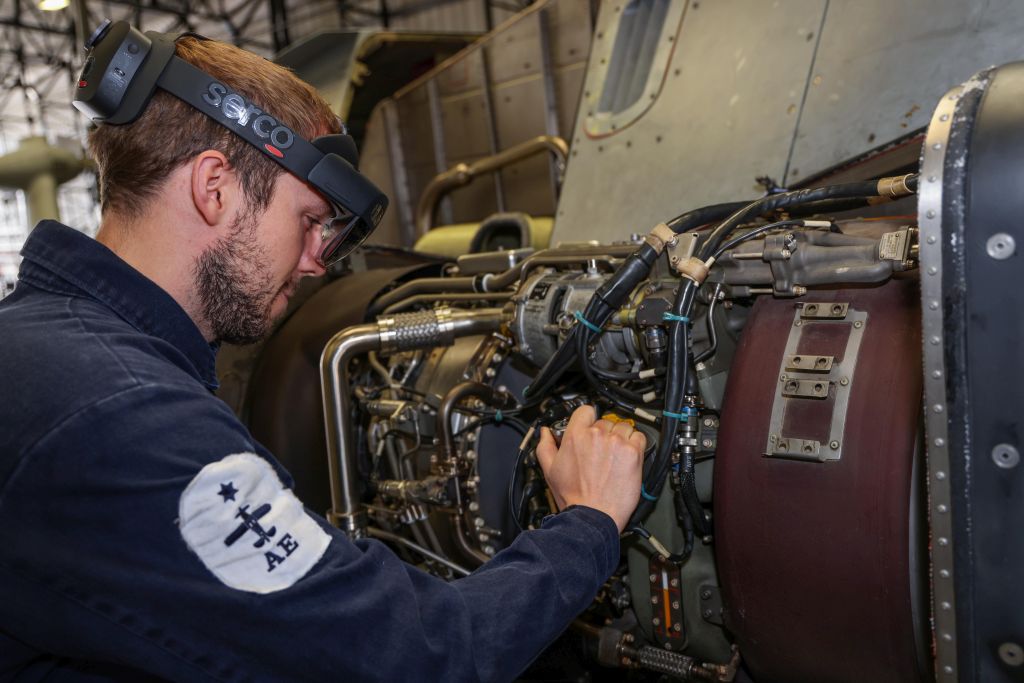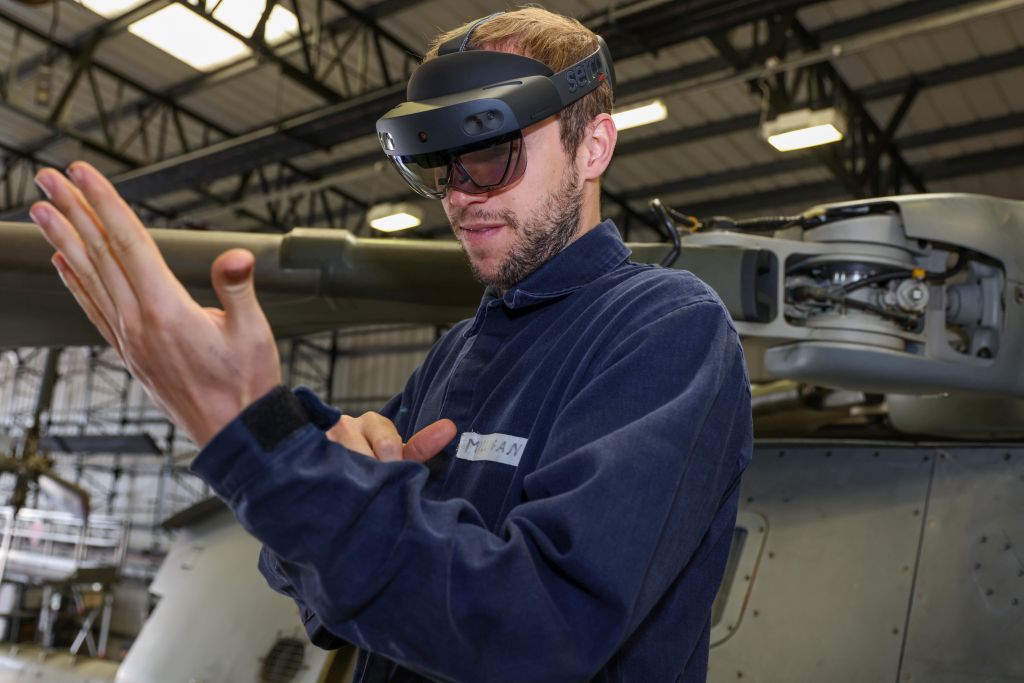Mixed reality overcomes operational challenges

Duncan McSporran, founder and COO, Kognitiv Spark looks at how mixed reality technology closes some of the critical knowledge gaps in aerospace manufacturing.
The military aerospace manufacturing sector is beset by challenges. Manufacturers must be focused on ensuring they are efficiently delivering new systems and components to their customers whilst also consistently keeping systems and platforms up and running through rigorous maintenance and repair.
Doing all this is complex and costly. However, the sector also must deal with large numbers of ageing engineers reaching retirement at the same time as experiencing the impacts of a younger more transient workforce. In addition to this, numerous companies in the aerospace engineering field are struggling with unprecedentedly high churn in their young technicians. This not only causes turbulence on the shopfloor, it also costs up to $100,000 for a company to hire, train and then lose a single engineer who stays for less than a year.
Given all these challenges, manufacturers need to look at ways of better enabling the engineers they do have to fill the shortfalls that increasingly exist today. The experience they have at their disposal must go further than it has ever done before.
Traditionally, one of the challenges manufacturers face is the frequent need to send engineers to sites that can be halfway across the world, to maintain and fix systems and components. Today, there are fewer engineers to send and, as a result, it will typically take longer to find a gap in the schedule to send them out to do the maintenance. In other words, it is increasingly difficult to get the knowledge where it is needed when it is needed.
Depending on specific circumstances, the wait time for engineers can often be for extended periods that impose significant cost and equipment non-availability on both the operator and the OEM. Consequently, system failures are having a significant downstream impact on OEMs as they struggle to provide timely and effective contracted support to the user or their service agents. This applies to the defence aerospace industry whatever the part they play in development, manufacture or support of engines, landing gear, avionics or the entire platform.
Finding a way forward
Fortunately, solutions to these complex challenges are increasingly coming on stream. One of the most promising areas today is the implementation and utilisation of fast-emerging advanced manufacturing technology of mixed reality (MR).
MR-based worker support is proving to be a powerful tool. Workers remain in their physical workspace and digital content is superimposed into their real-world view to enable interaction with the workspace and virtual objects. MR also allows remote workers to establish a secure video and audio call with support teams or subject matter experts when they need help solving a complex problem. The expert, who can be located anywhere, can see what the remote worker sees and provide verbal and visual guidance. In the more sophisticated MR systems, the user can also simultaneously access holographic assets to support the task, all while remaining ‘heads-up’ and ‘hands-free’.

This approach is highly-effective in complex operations. Being able to deal with issues ‘on the fly’, through MR technology, helps eliminate equipment downtime and reduce time to resolution. Over and above this, MR is reducing the need for expert engineers to travel to site to oversee or conduct engineering tasks that are often conducted in a short time frame.
Less experienced engineers may struggle to quickly absorb all the necessary information they need to maintain and fix equipment efficiently and well. That’s especially the case in the military. As Nick Slater, strategic development director at Kognitiv Spark partner, Serco, commented: “Today, military aerospace engineers need to have so much more in their heads than ever before. And that's not possible as a human. They can’t be an expert in absolutely everything, especially with more complex platforms. So, the ability to use MR technology to deliver support ‘at reach’ through what we term capability as-a-service, is crucial in enabling our key defence customers to maintain their assets.”
In significant research it has been proven that when a less experienced worker engages in an unfamiliar operation using MR, their knowledge retention surpasses that of using a manual or pdf. This applies equally to systems assembly or quality assurance or downstream maintenance. The benefit of regenerative training at the point of need – on the assembly - is especially clear where the individuals might have only previously completed a task during classroom sessions.
By using the highly cognitive capabilities of MR in a task, the grasp of the subject matter becomes more profound. This experiential approach, putting the required knowledge at the “point of need”, enhances the understanding of the user and likelihood of completing a task without mistake or assistance. MR makes the knowledge more tangible and easier to remember compared to relying solely on a traditional manual, whether that is a paper or digital source.
Worker morale is also raised where MR is used as a tool. Less experienced engineers feel they are achieving something positive as part of a team effort. They can improve upon their own contributions. And if they get a real sense that their contribution matters to the success of the project, they are more likely to stay with the organisation over the long-term.
MR implementation is also not only key to reducing equipment downtime, but also maintenance-related travel. Other benefits include much more rapid diagnosis of issues, and leveraging such technology ensures that mission critical systems and aircraft remain at high operational readiness for routine training and deployments.
Looking ahead
As we look to the future and move forward with digital transformation, MR will bring further benefits. In the future, we will inevitably see digital convergence. Integration and greater use of Internet of Things (IoT) sensors feeding information to people and Artificial Intelligence (AI) driven predictive analysis, as just two examples. We will also witness more materials analysis taking place not just of equipment but also of the surfaces that people are working on. All that information will come on stream but will be presented in different ways.
In this context, MR will help to reduce the issue of sensory overload for engineers, by presenting information visually in three dimensions to them at the point of need. Over time, MR will evolve into a more fully realised spatial computing environment where information will come together and make itself available to the digitally enabled aerospace engineer. And being able to have all this merged in one environment, where it is visual, and therefore does not increase the cognitive load on the engineer, is a phenomenal step forward.

The other great benefit of MR technology stems from its affordability. In our experience, every customer that takes this technology and starts to use it, can attain real, tangible, operational and financial benefit within eight to 12 weeks., It sometimes takes a little time for them to roll it out and get it into the hands of their team. But as soon as they employ it, they're seeing the benefits.
In terms of accessibility, in our experience, it is not unusual to see engineers begin using the capability 45 minutes after they have received a system in a box, having never put a computer on their head before. In short, well selected MR systems can be easy to use. Engineers can rapidly master it and typically feel comfortable using it from the outset.
As Serco’s Slater concludes: “Within the military aerospace manufacturing sector, we are increasingly seeing that mixed reality is not just another piece of tech. It is a real enabler that does support positive outcomes. After all, if you can keep an aircraft flying longer between faults or problems or maintenance because you can have an expert, potentially even the manufacturer, remotely helping an onsite engineer maintain an aircraft or a motor vehicle, you can enable them to do their job better, and ensure the whole operation is running as efficiently as possible. Having that knowledge and experience available at the point of need is critically important to the military and becoming more so over time.”













